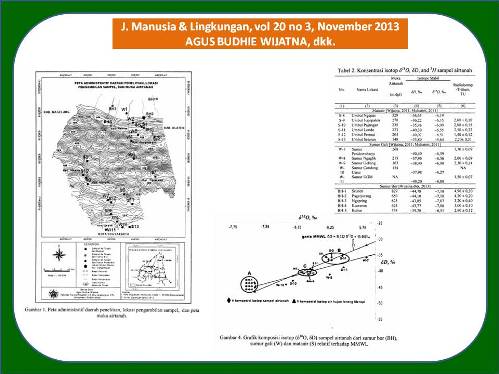
STUDI KONEKTIVITAS AKUIFER ANTARA SUMUR BOR DENGAN SUMBER DAYA AIR DI BAWAHNYA (Study on Aquifer Connectivity, between Boreholes with water resources underneath)
Agus Budhie Wijatna(1*), Sudarmadji Sudarmadji(2), Sunarno Sunarno(3), Heru Hendrayana(4)
(1) Sekolah Pasca Sarjana/Fakultas Teknik UGM
(2) Fakultas Geografi Universitas Gadjah Mada, Yogyakarta, Indonesia
(3) Fakultas Teknik Universitas Gadjah Mada, Yogyakarta, Indonesia
(4) Fakultas Teknik Universitas Gadjah Mada, Yogyakarta, Indonesia
(*) Corresponding Author
Abstract
ABSTRAK
Untuk memenuhi kebutuhan air bersih bagi penduduk di daerah bekas bencana letusan Gunung Merapi, Kabupaten Sleman, DIY, telah dibuat 5 sumur bor di Dusun Srunen (BH1), Pagerjurang (BH2), Ngepring (BH3), Kuweron (BH4), dan di Dusun Bubur (BH5). Pembuatan sumur bor pada elevasi antara 544 sampai 846 m.dpl, dengan kedalaman antara 98-146 m dan debit pengambilan airtanah rerata 9-10 liter per detik tersebut dikawatirkan akan mempengaruhi kondisi muka airtanah sumur gali di Dusun Pendowoharjo (W7), Ngaglik (W8), Gebang (W9), Condong Catur (W10), sumur UGM (W11) dan mempengaruhi debit umbul (mataair) Ngepas (S8), Umbul Jogopaten (S9), Umbul Pajangan (S10), Umbul Londo (S11), Umbul Permai (S12), dan Umbul Seturan (S13), yang berada pada elevasi 148-329 m.dpl. Secara teoritis, pengambilan airtanah di sumur bor akan berpengaruh jika terdapat interkoneksi hidraulik antara sumur bor dengan sumur gali dan mataair. Pada penelitian ini, interkoneksi hidraulik antara sumur bor dengan sumur gali dan mataair dilakukan menggunakan isotop lingkungan (D, 3H dan 18O). Penelitian diawali dengan menentukan lokasi pengambilan sampel airtanah berdasarkan peta topografi dan kondisi hidrologi; sampel airtanah diambil dari sumur bor, sumur gali dan mataair sebanyak 30 ml dan 1.000 ml; rasio isotop δD dan δ18O pada sampel airtanah diukur dengan liquid-water stable isotope analyzer LGR DLT-100, sedangkan kadar tritium diukur dengan Liquid Scientillation Counter (LSC) Tri Carb 1900 TR. Genesis sampel airtanah ditentukan berdasarkan komposisi isotop (δ18O, δD) dengan mengacu pada persamaan Merapi Meteoric Water Line (MMWL); sedangkan untuk memastikan adanya interkoneksi hidraulik, maka hasil pengukuran kadar tritium dianalisis dengan tritium dating method. Hasil penelitian menunjukkan bahwa genesis airtanah di BH1, BH2, BH3, dan BH4 berbeda dengan genesis airtanah sumur gali dan mataair di bawahnya. Sehingga dapat disimpulkan airtanah sumur bor di BH1, BH2, BH3, dan BH4 tidak memiliki interkoneksi hidraulik dengan airtanah di sumur gali W7, W8, W9, W11 dan W12, maupun airtanah di mataair S8, S9, S10, S11, S12, dan S13. Sedangkan airtanah di sumur bor BH5, W7, S11 dan S12 memiliki genesis yang sama, dengan rasio isotop berkisar antara ‒40,40‰ sd. ‒39,20‰ untuk δD dan ‒6,59‰ sd. ‒6,51‰ untuk δ18O, sehingga diperkirakan airtanah di BH5 memiliki interkoneksi hidraulik dengan airtanah di W7, S11 dan S12. Kadar tritium di BH5 = 2,9TU lebih muda daripada umur tritium di W7 (= 1,7TU), S11(=2,5TU) dan S12 (= 1,4TU), sehingga diperkirakan airtanah di BH5 mengalir ke W7, S11 dan S12. Sedangkan komposisi isotop airtanah di S8, S9, dan S10 adalah ‒36,65‰ sd. ‒35,98‰ untuk δD dan ‒6,19‰ sd. ‒6,09‰ untuk δ18O. Nilai komposisi isotop airtanah di S8, S9, dan S10 hampir berimpit dengan garis MMWL, sehingga dapat disimpulkan sebagian besar airtanah di S8, S9, dan S10 berasal dari airhujan lokal.
ABSTRACT
To meet the needs of clean water for the people in the former of mount Merapi eruption disaster area at Sleman Regency, it has been made five boreholes at Dusun Srunen (BH1), Pagerjurang (BH2), Ngepring (BH3), Kuweron (BH4), and at Dusun Bubur (BH5). The groundwater abstraction of 9-10 liters.sec‒1 on each boreholes which located at an elevation of between 544 to 846 m.asl, with depths of between 98 to 146 m is feared will influence water-level of the dug wells at Dusun Pendowoharjo (W7), Ngaglik (W8), Gebang (W9), Condong Catur (W10), wells UGM (W11) and also will influence water-level of the springs of Jogopaten (S9), springs of Pajangan (S10), springs of Londo (S11), springs of Permai (S12), and the springs of Seturan (S13) which located at an elevation of 148-280 m.dpl. Theoretically, groundwater abstraction on boreholes will take effect if there is a hydraulic interconnection between the boreholes with dug wells and springs. The hydraulic interconnection between the boreholes with dug wells and springs investigated using natural isotopes (D, 3H and 18O). The research initiated by determining the location of groundwater sampling based on topographic maps and hydrological conditions; groundwater samples taken from boreholes, dug wells and springs as much as 30 ml and 1.000 ml; δD and δ18O isotope ratios of groundwater samples were measured using a Liquid-Water Stabel Isotope Analyzer LGR DLT -100, while the tritium levels were measured by Liquid Scientillation Counter (LSC) Tri Carb 1900 TR. Isotope ratios of δD and δ18O were analyzed by referring to Merapi Meteoric Water Line (MMWL) to determine the genesis of groundwater samples, whereas the rate of tritium were analyzed using tritium dating method to ensure the hydraulic interconnection. The results of this research is the isotopic composition of groundwater in the BH1, BH2, BH3, and BH4 different with isotopic composition of groundwater in dug wells (W) and springs (S). It is indicated that there is no a hydraulic interconnection of groundwater system between BH1, BH2, BH3, and BH4 with groundwater system of W7, W8, W9, W10 and W11 and the S9, S10, S11, S12, and S13. While groundwater in BH5, W9 and S13 have the same genesis with isotope ratios ranged from ‒6,53‰ to ‒6,63‰ for δ18O and ‒40,9‰ to ‒40,3‰ for δD, therefore it is estimated that there is a hydraulic interconnection between BH5 with W9 and S13. Levels of tritium in BH5 = 2,9TU is younger than W9 (= 2,3TU) and S13 (= 2,2TU), it is estimated that groundwater in BH5 flows to Gebang well (W9) and Seturan springs (S13). Isotopic composition of groundwater in S9, S12, and W11 ranged from ‒6,24‰ to ‒6,02‰ for δ18O and ‒36,7‰ to ‒35,4‰ for δD. These isotope ratios are similar to the isotopic composition of rainfall on MMWL. Therefore, the most of the groundwater in the S9, S12, and W11 derived from local rainfall.
Keywords
Full Text:
Artikel lengkap (PDF) (Bahasa Indonesia)Article Metrics
Refbacks
- There are currently no refbacks.
Copyright (c) 2017 Jurnal Manusia dan Lingkungan







